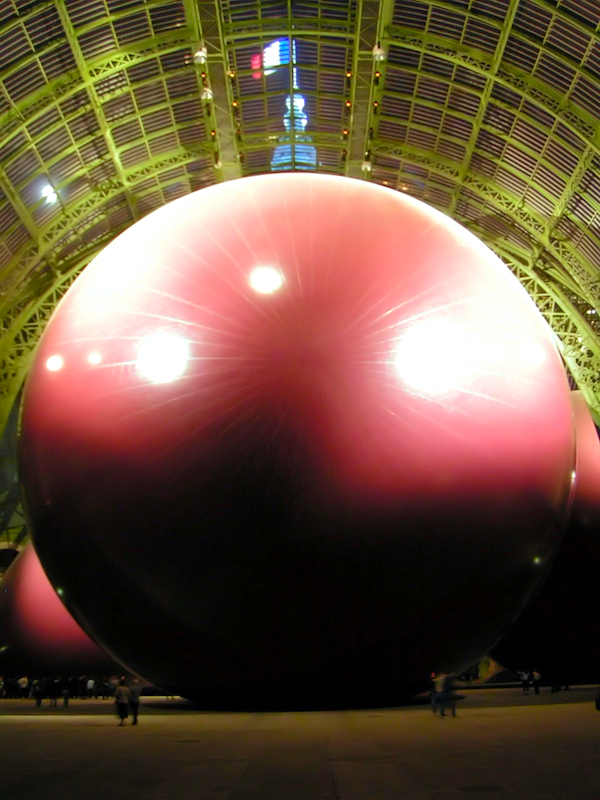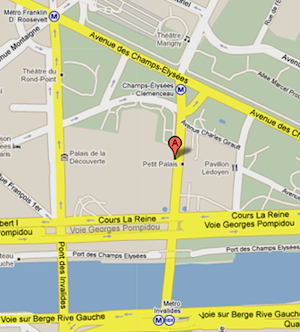Monumenta 2011: Leviathan at Grand Palais by Anish Kapoor

- SUBSCRIBE
- ALREADY SUBSCRIBED?
BECOME A BONJOUR PARIS MEMBER
Gain full access to our collection of over 5,000 articles and bring the City of Light into your life. Just 60 USD per year.
Find out why you should become a member here.
Sign in
Fill in your credentials below.
 Seven hundred words. That was the assignment, to write seven hundred words about Leviathan, Anish Kapoor’s Monumenta 2011 installation showing at the Grand Palais Museum in Paris until June 23, 2011. Initially, the task seemed much less daunting than the actual size of the work I was to critique, but that shows how much I know and even more how much I don’t. Standing before the behemoth and trying to mentally construct this article, I came face-to-face with the enormity of something other than the work confronting me: I was speechless concerning what to say about the sculpture, if indeed “sculpture” is even the right word for something of such epic proportions. Yet the pen is mightier than the sword and, armed with an ego at least as large as this bauble, I would be damned before letting Leviathan get the best of me.
Seven hundred words. That was the assignment, to write seven hundred words about Leviathan, Anish Kapoor’s Monumenta 2011 installation showing at the Grand Palais Museum in Paris until June 23, 2011. Initially, the task seemed much less daunting than the actual size of the work I was to critique, but that shows how much I know and even more how much I don’t. Standing before the behemoth and trying to mentally construct this article, I came face-to-face with the enormity of something other than the work confronting me: I was speechless concerning what to say about the sculpture, if indeed “sculpture” is even the right word for something of such epic proportions. Yet the pen is mightier than the sword and, armed with an ego at least as large as this bauble, I would be damned before letting Leviathan get the best of me.
The artist’s challenge: finding display space for art that tops 100 feet in height
In fact, the irony of having nothing to say about a phenomenon so large it requires an entire museum to house it is exactly what Kapoor intended to achieve with Leviathan. In constructing such a monumental entity, he intentionally de-objectified the object by turning a thing into no-thing.
Monumenta: annual show for gigantic installations 
Nothing could be more fitting for the Monumenta 2011 series than this contribution. A yearly event since 2007 (with the exception of 2009), the French Minister of Culture and Communication annually selects an artist of international renown to create artwork of such proportion that can fill the Grand Palais exhibition hall. This year’s masterpiece meets and exceeds the goal better than any other since the ev ent’s creation.
The observer’s challenge: how to absorb and assess when all cannot be seen
Leviathan’s sheer mass squeezed into the girdle and bonnet of the Grand Palais refuses the visitor a frame of reference. Spectators are forced to observe the work section by section and to approximate a mental picture that does not resemble sculpture, monument, building or anything else that can be named. In so doing, Kapoor created something that cannot be named, that cannot be “known.” That is how he strips his Leviathan of everything recognizable. What remains after senses are deprived of the artifices normally relied upon is an object that is no longer an object. Anish Kapoor succeeds in this gloriously, but does this success mean he has created an objet d’art?
With total immersion, viewer and art become one
To best answer this question, take a closer look at the monster. Leviathan is aptly named because its volume bequeaths life-like qualities to it. Beginning by passing through the revolving door into the belly of the giant, visitors are enveloped in soft material, a monochrome red glow and the ribbed walls of the goliath. The sensation approximates, perhaps, occupying a giant womb, along with a throng of friends and strangers alike.
Guests then exit another door, out of Leviathan’s gullet and into the Grand Palais, where the outer form of the work lies. The color is a less vivid red than that of the inside and the exterior has a hard shell to protect the vulnerable insides. Place your hand against the wood-like rubber plastic hull and feel the entire three-story globe shy away from your touch. Press your ear against the orb and, between the echoed rumbles of the voices inside, listen to the air circulating like blood through the Leviathan.
 Experience Leviathan
Experience Leviathan
An object that is no longer an object, an artwork so large it cannot be seen but must be experienced, a sculpture that appears to be coming to life is all well and good, but is it art? Kapoor’s Leviathan certainly demands more than a cursory glance if it is to be appreciated or understood. Thought and effort must be dedicated to it to penetrate its mysteries and get past its size. Is it art? I’ll let you know as soon as I get a check as big as the Leviathan for these 717 words.
Paul Prescott has written several articles for BonjourParis, most recently Salon de la Mort: Louvre Exhibition. More at his Paris Inspired Website or write to him at Paul Prescott.
Photo credits:
All photos ©Paul Prescott and ©ParisKarin aka karinlynn68
Tel: 01 44 13 17 17
Main entry: 3, avenue Winston-Churchill, Paris 8th
Exhibition room: Nave of the Grand Palais
Hours: Open daily except Tuesdays.
Mondays and Wednesdays: 10:00AM-7:00PM.
Thursdays to Sundays: 10:00AM-midnight.
Admissions close 45 minutes before exhibition closing.
 Admission: 5€ adults, free for children under 12 accompanied by adult. Discounts for students, seniors, persons with disabilities—contact museum for details.
Admission: 5€ adults, free for children under 12 accompanied by adult. Discounts for students, seniors, persons with disabilities—contact museum for details.
Métro: lines 1, 9, 13 / Stations : Franklin D. Roosevelt, Champs-Elysées-Clémenceau
RER: Line C, Station: Invalides
Bus: Lines 28, 42, 52, 72, 73, 80, 83, 93
Vélib’: 8029, 8001
Accessibility: enter main Grand Palais exhibition areas via administrative entry on avenue Winston Churchill; wheelchair rent (call to confirm availability)
Show closes Thursday, June 23, 2011
Video interview with Anish Kapoor by le Figaro
More in Anish Kapoor, Art, artists, Bonjour Paris, Grand Palais, Leviathan, modern art, Monumenta, Museum, Paris, Paris art exhibits, Paris art museums, Paris exhibitions, Paris galleries, Paris museums, Paris sightseeing, Paris tourism, Paris tourist tips, Paul Prescott, performance art



